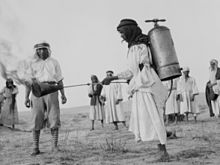| Revision as of 23:56, 30 March 2013 editHydrargyrum (talk | contribs)Extended confirmed users43,643 editsm →Reaction← Previous edit | Revision as of 18:53, 18 June 2013 edit undoGreyshark09 (talk | contribs)Extended confirmed users, Pending changes reviewers42,564 editsNo edit summaryNext edit → | ||
| Line 9: | Line 9: | ||
| | data2 = 1915 | | data2 = 1915 | ||
| | label3 = Location: | | label3 = Location: | ||
| | data3 = ] | | data3 = ] | ||
| | label4 = Effect: | | label4 = Effect: | ||
| | data4 = Higher food prices, starvation | | data4 = Higher food prices, starvation | ||
| }} | }} | ||
| From March to October 1915, ] of ]s stripped areas in and around ] of almost all ]. This infestation seriously compromised the already-depleted ] of the region and sharpened the misery of all ]ites.<ref name=loc>{{cite web|url=http://memory.loc.gov/ammem/collections/americancolony/locusts.html|title=The Locust Plague of 1915 Photograph Album|publisher=Library of Congress|accessdate=2011-01-07| archiveurl= http://web.archive.org/web/20110107011258/http://memory.loc.gov/ammem/collections/americancolony/locusts.html| archivedate= 07 January 2011 <!--DASHBot-->| deadurl= no}}</ref> | From March to October 1915, ] of ]s stripped areas in and around ] of almost all ]. This infestation seriously compromised the already-depleted ] of the region and sharpened the misery of all ]ites.<ref name=loc>{{cite web|url=http://memory.loc.gov/ammem/collections/americancolony/locusts.html|title=The Locust Plague of 1915 Photograph Album|publisher=Library of Congress|accessdate=2011-01-07| archiveurl= http://web.archive.org/web/20110107011258/http://memory.loc.gov/ammem/collections/americancolony/locusts.html| archivedate= 07 January 2011 <!--DASHBot-->| deadurl= no}}</ref> | ||
| The crop destruction resulted in several increases to the price of food. On April 25, 1915, '']'' described the price increases. "Flour costs ]15 a sack. Potatoes are six times the ordinary price. Sugar and petroleum are unprocurable and money has ceased to circulate."<ref>{{cite news|url=http://query.nytimes.com/mem/archive-free/pdf?res=9D06E4DE1338E633A25750C2A9629C946496D6CF|title=Distress in Jerusalem|date=1915-04-23|publisher=New York Times|accessdate=2008-08-05 | format=PDF}}</ref> | The crop destruction resulted in several increases to the price of food. On April 25, 1915, '']'' described the price increases. "Flour costs ]15 a sack. Potatoes are six times the ordinary price. Sugar and petroleum are unprocurable and money has ceased to circulate."<ref>{{cite news|url=http://query.nytimes.com/mem/archive-free/pdf?res=9D06E4DE1338E633A25750C2A9629C946496D6CF|title=Distress in Jerusalem|date=1915-04-23|publisher=New York Times|accessdate=2008-08-05 | format=PDF}}</ref> | ||
| Line 37: | Line 37: | ||
| ] | ] | ||
| ] | ] | ||
| ] | |||
| ] | ] | ||
| ] | ] | ||
| ] | ] | ||
| ] | |||
Revision as of 18:53, 18 June 2013
| 1915 Palestine locust infestation | |
|---|---|
 Locust from the 1915 infestation Locust from the 1915 infestation | |
| Date | 1915 |
| Location: | Ottoman Syria |
| Effect: | Higher food prices, starvation |
From March to October 1915, swarms of locusts stripped areas in and around Southern Syria of almost all vegetation. This infestation seriously compromised the already-depleted food supply of the region and sharpened the misery of all Jerusalemites.
The crop destruction resulted in several increases to the price of food. On April 25, 1915, The New York Times described the price increases. "Flour costs $15 a sack. Potatoes are six times the ordinary price. Sugar and petroleum are unprocurable and money has ceased to circulate."
Reaction
Djemal Pasha, who was the Supreme Commander of Syria and Arabia at the time of the locust infestation, launched a campaign to limit the devastation of the incident. He appointed an official to fight the infestation.
Many people believed that prayer and petition were required to end the plague, as they viewed the swarm of locusts as a punishment from God for their sins. Rav A.M. Luntz, who observed the development of the infestation said that "... Badatz decreed that on the following day there should be a Taanit Tzibbur and the whole day should be one of selichot, prayer and petition. After a few days the locusts left the Land ... " as locusts do after they have finished feeding. However, in the amount of time they nested there, the locusts replenished themselves with new larvae.
Regulations

Midhat Bay, who was the official appointed to fight the infestation, helped enact a law which required every male between ages 15 and 60 in cities to collect 20 kilograms of locust eggs or pay a fine of £4.40. The New York Times reported that this law was strictly enforced. They said that people who failed to follow the law risked having their businesses closed. Eight hundred people had paid the fine by November 21, 1915.
The locust infestation was also responsible for death due to diseases that were brought by the locusts.
See also
References
- ^ "The Locust Plague of 1915 Photograph Album". Library of Congress. Archived from the original on 07 January 2011. Retrieved 2011-01-07.
{{cite web}}: Check date values in:|archivedate=(help); Unknown parameter|deadurl=ignored (|url-status=suggested) (help) - "Distress in Jerusalem" (PDF). New York Times. 1915-04-23. Retrieved 2008-08-05.
- ^ "Remarkable Details From American Consul on Palestine Locust Plague" (PDF). New York Times. 1915-11-21. Retrieved 2008-08-05.
- Student, Gil (2002-01-20). "Did the prophet Yoel contradict the Torah?". aishdas.org. Retrieved 2008-08-05.
- ^ "The Plague Approacheth". Lamed. 2004-11-21. Retrieved 2008-08-05.